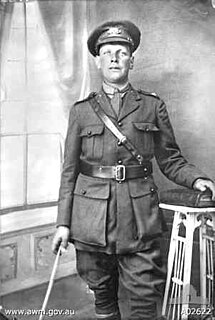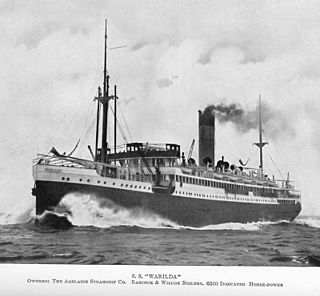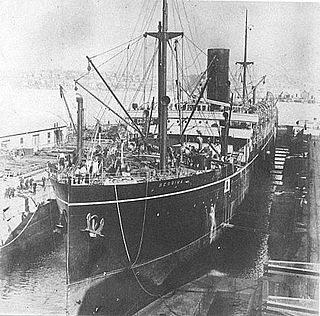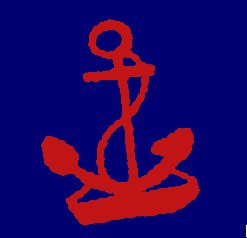
A troopship is a ship used to carry soldiers, either in peacetime or wartime. Troopships were often drafted from commercial shipping fleets, and were unable land troops directly on shore, typically loading and unloading at a seaport or onto smaller vessels, either tenders or barges.

HMAS Sydney (R17/A214/P214/L134) was a Majestic-class light aircraft carrier operated by the Royal Australian Navy (RAN). She was built for the Royal Navy and was launched as HMS Terrible (93) in 1944, but was not completed before the end of World War II. The carrier was sold to Australia in 1947, completed, and commissioned into the RAN as Sydney in 1948.

Martin O'Meara, VC was an Irish-born Australian recipient of the Victoria Cross, the highest award for gallantry in the face of the enemy that can be awarded to British and Commonwealth forces.

Alfred Edward Gaby, VC was an Australian recipient of the Victoria Cross, the highest award for gallantry in the face of the enemy that can be awarded to British and Commonwealth forces.

Wyreema was an Australian steamship named after the town of Wyreema, Queensland.

Blackboy Hill was named after the Australian native "black boy" plants, Xanthorrhoea preissii, which dominated the site which is now absorbed into Greenmount, Western Australia.

Woodman Point is a headland on the west coast of Western Australia. It is located in the Perth suburb of Coogee, 22 km (14 mi) south-south-west of the city centre and 8 km (5.0 mi) south of Fremantle. It extends westward into the Indian Ocean. The coastal waters immediately to the north of the point are known as Owen Anchorage, while to the south is Jervoise Bay. Woodman Point marks the northern extent of Cockburn Sound.

HMAT Warilda was a 7713-ton vessel, built by William Beardmore and Company in Glasgow as the SS Warilda for the Adelaide Steamship Company. She was designed for the East-West Australian coastal service, but following the start of the First World War, she was converted into a troopship and later, in 1916, she was converted into a hospital ship.

HMAS Berrima was a passenger liner which served in the Royal Australian Navy (RAN) during World War I as an armed merchantman and troop transport. Launched in 1913 as the P&O liner SS Berrima, the ship initially carried immigrants from the United Kingdom to Australia via Cape Town. In August 1914, Berrima was requisitioned for military use, refitted and armed, and commissioned into the RAN as an auxiliary cruiser. The ship transported two battalions of the Australian Naval and Military Expeditionary Force to the German New Guinea colonies in September.

Talune has been the name of three vessels. This article refers to the first SS Talune, built in 1890 and scuttled in 1925.

The Royal Australian Naval Bridging Train was a unique unit of the Royal Australian Navy. It was active only during the First World War, where it served in the Gallipoli and the Sinai and Palestine Campaigns. The Train was formed in February 1915 and stood down in May 1917. Throughout its existence, it was composed of Royal Australian Naval Reservists under the command of Lieutenant Commander Leighton Bracegirdle. Normally under the command of the British IX Corps, the Train also supported the I ANZAC Corps and Imperial Camel Corps in the defence of the Suez Canal.
They were the only Australian naval unit serving in a European theatre of war. They were therefore bent on proving, both to the Royal Navy and to the British Army, that they could overcome any difficulties.

Fremantle Harbour is Western Australia's largest and busiest general cargo port and an important historical site. The inner harbour handles a large volume of sea containers, vehicle imports and livestock exports, cruise shipping and naval visits, and operates 24 hours a day. It is located adjacent to the city of Fremantle, in the Perth metropolitan region.

The Wallach brothers were a family of eight boys born to Henry and Mary Wallach of Bondi Beach in Sydney, Australia toward the end of the 19th century. Six of the brothers all saw active service in World War I. The fourth and eighth brothers, Clarrie and Neville were both top-grade rugby union players before the War. They both saw action at Gallipoli, were promoted on the Western Front as Captains, were both recipients of the Military Cross and each fell within a week of each other in France in fighting at the time of the Second Battle of Villers-Bretonneux.

SS Wandilla was a steamship built in 1912 for the Adelaide Steamship Company. The ship operated on the Fremantle to Sydney run until 1915, when she was acquired for military service and redesignated HMAT Wandilla. Initially used as a troop transport, the vessel was converted to a hospital ship in 1916. Wandilla was returned to her owners at the end of the war, then was sold to the Bermuda & West Indies SS Company and renamed Fort St. George in 1921. She was sold in 1935 to Lloyd Triestino and renamed Cesarea before being renamed Arno in 1938. At the start of World War II, the ship was acquired by the Regia Marina for use as a hospital ship. She was sunk by British aircraft on 10 September 1942.

The 2nd Light Horse Regiment was a mounted infantry regiment of the Australian Army during the First World War. The regiment was raised in September 1914, and by December as part of the 1st Light Horse Brigade had moved overseas. During the war the regiment only fought against the forces of the Ottoman Empire, in Egypt, at Gallipoli, on the Sinai Peninsula, and in Palestine and Jordan. After the armistice the regiment eventually returned to Australia in March 1919. For its role in the war the regiment was awarded nineteen battle honours.
Samuel Cleland Campbell was an Australian rules footballer who played with Collingwood in the Victorian Football League (VFL).

Operation Pamphlet, also called Convoy Pamphlet, was a World War II convoy operation conducted during January and February 1943 to transport the 9th Australian Division home from Egypt. The convoy involved five transports, which were protected from Japanese warships by several Allied naval task forces during the trip across the Indian Ocean and along the Australian coast. The division embarked in late January 1943 and the convoy operation began on 4 February. No contact was made between Allied and Japanese ships, and the division arrived in Australian ports during late February with no losses from enemy action.

SS Katoomba was a passenger steamship that was built in Ireland 1913, spent most of her career in Australian ownership and was scrapped in Japan in 1959. McIlwraith, McEacharn & Co owned her for more than three decades, including two periods when she was a troopship. In 1946 the Goulandris brothers bought her for their Greek Line and registered her in Panama. In 1949 she was renamed Columbia.

Geelong was a ship which owned by the Blue Anchor Line, and, after 1910, by P&O. She was constructed in 1904 by Barclay, Curle and Co. Ltd., at Glasgow, Scotland. When originally constructed, she had accommodation for 120 saloon and 200 third-class passengers, and also carried cargo. Her gross register tonnage was 7700 tons, and she was 450 feet long, powered by triple-expansion steam engines, and capable of 14 knots, with an average cruise speed of 12 knots.

SS Georgetown Victory was a Victory ship built for the War Shipping Administration late in World War II under the Emergency Shipbuilding program. She was a type VC2-S-AP2/WSAT cargo ship with the United States Maritime Commission (MCV) -"Victory"; hull number 653, shipyard number 1597 and built by Bethlehem Shipbuilding Corporation in Baltimore, Maryland, she was laid down on 8 March 1945. Georgetown Victory, named after Georgetown University, was launched from the Bethlehem-Fairfield shipyard at Baltimore on April 28, 1945 and completed on 22 May 1945.





















